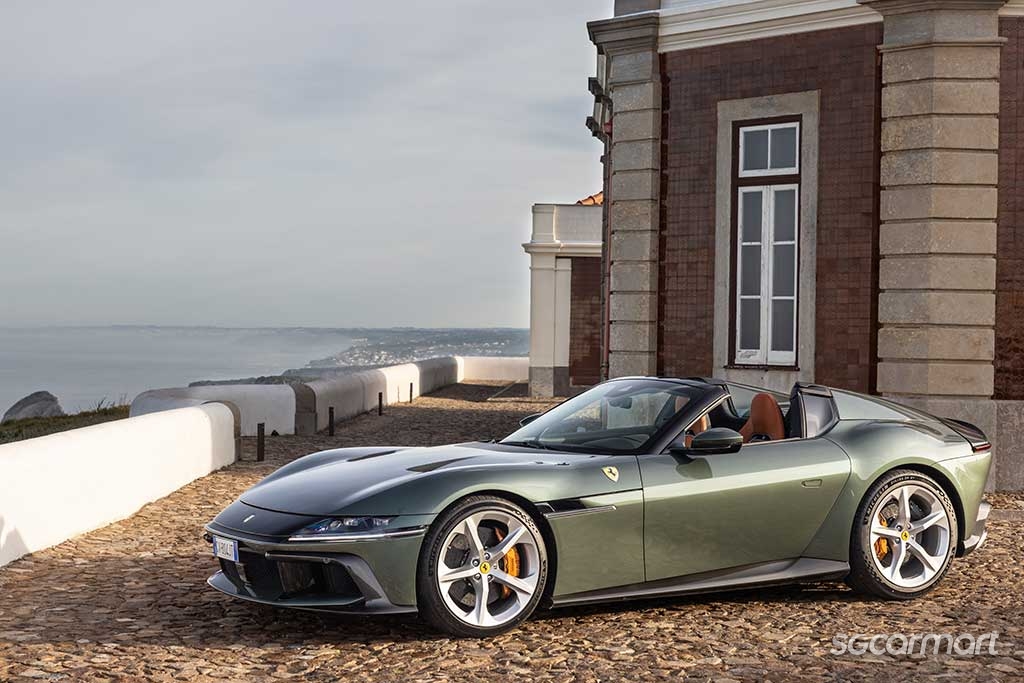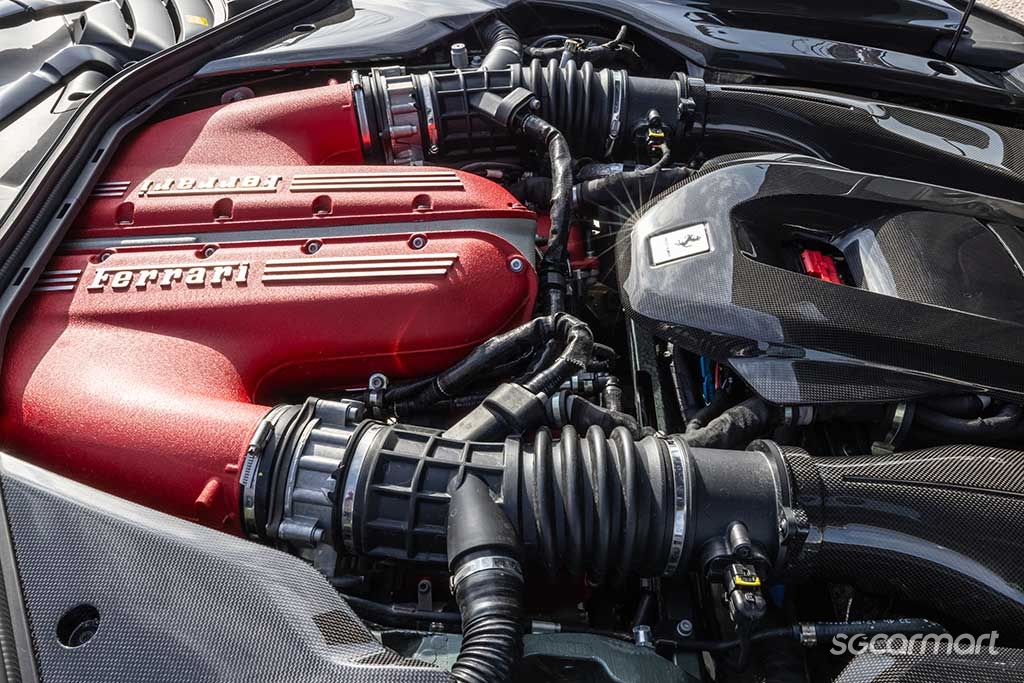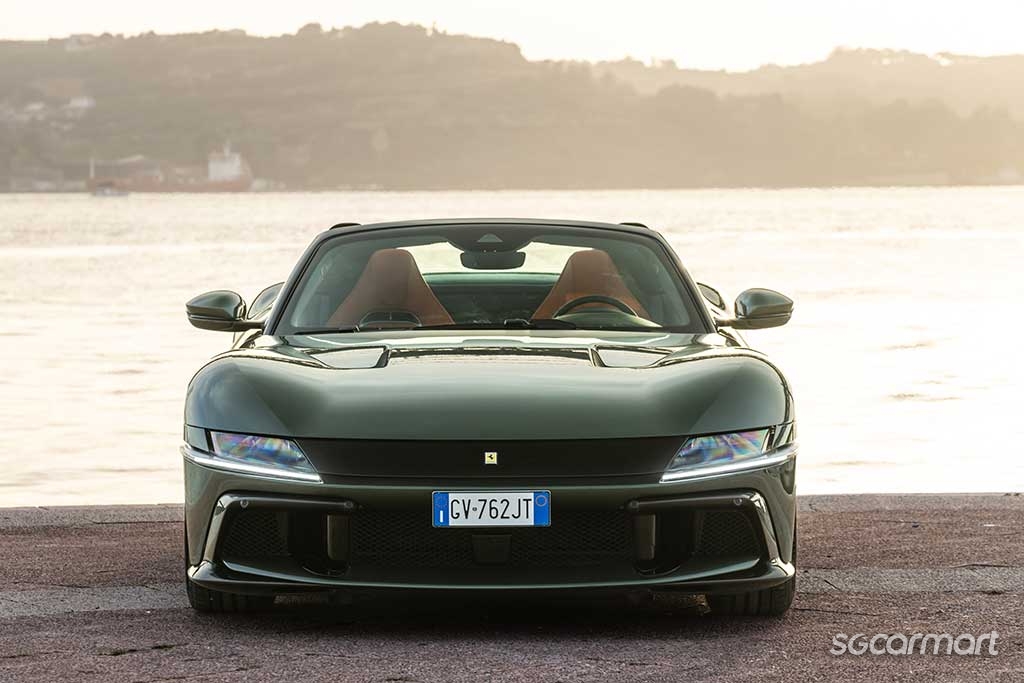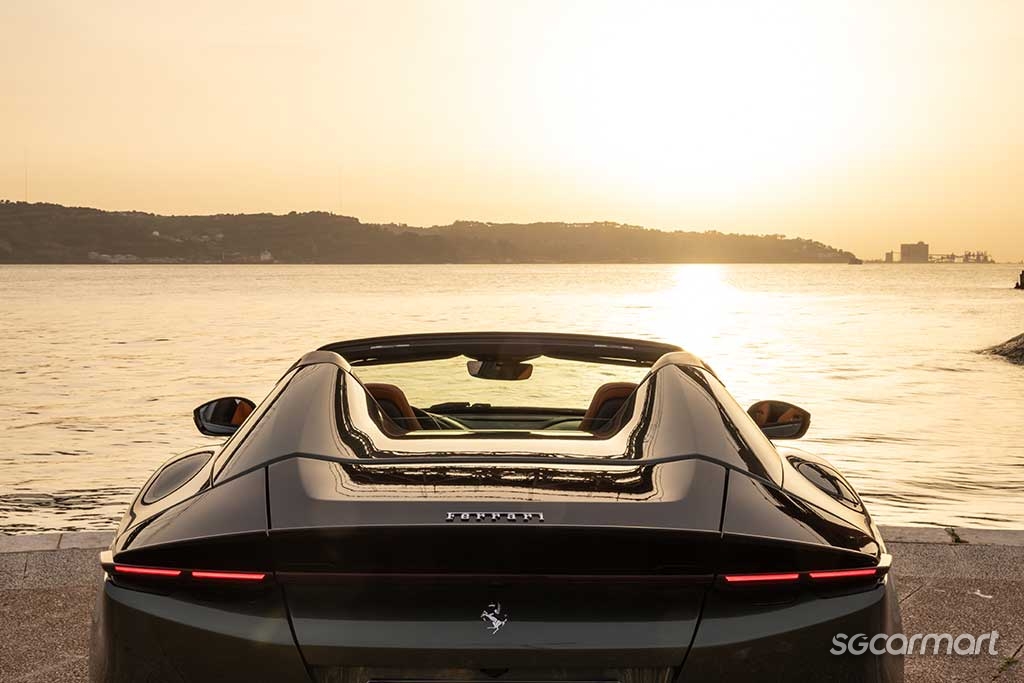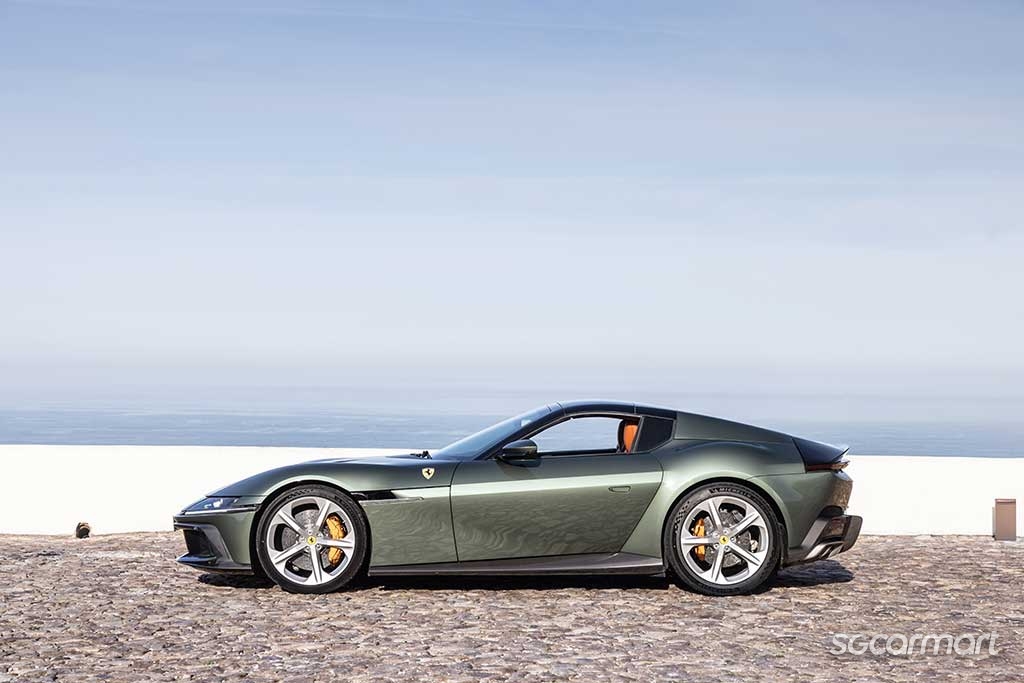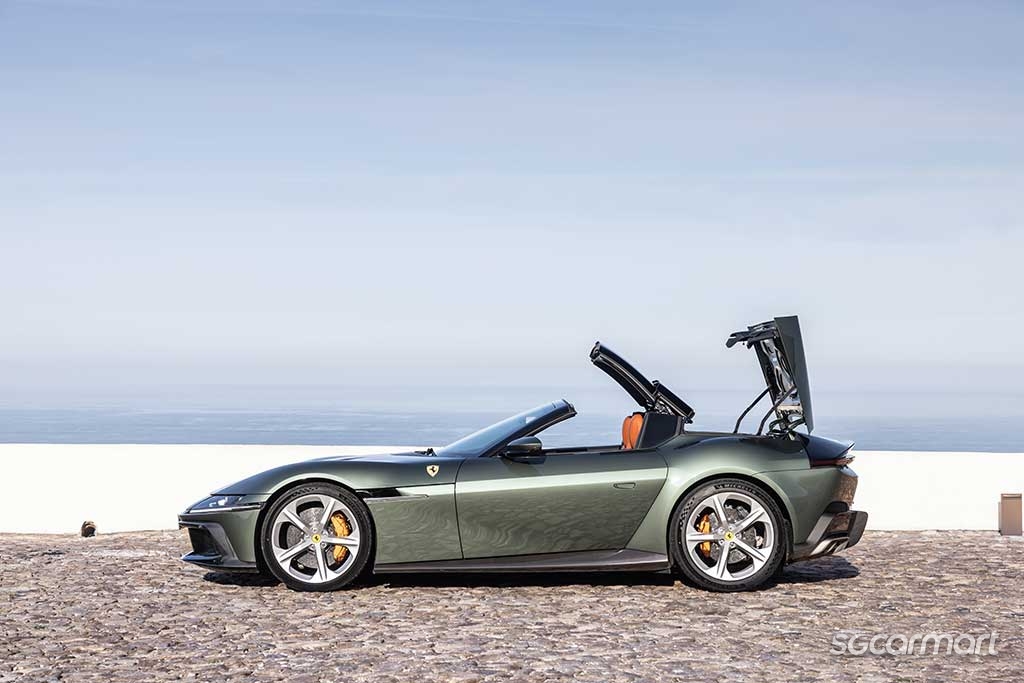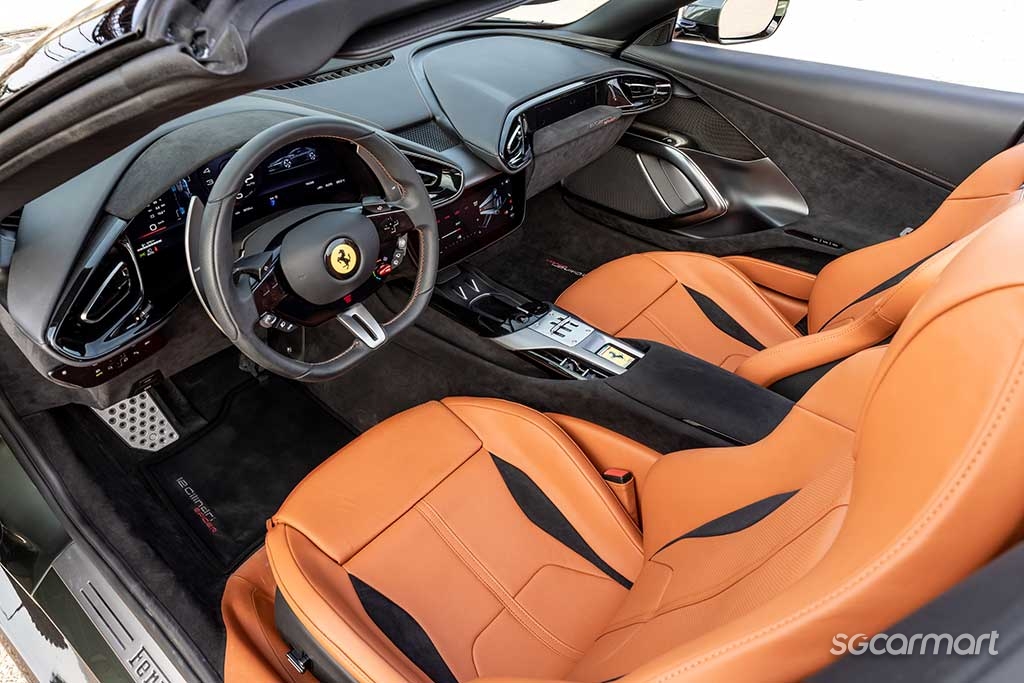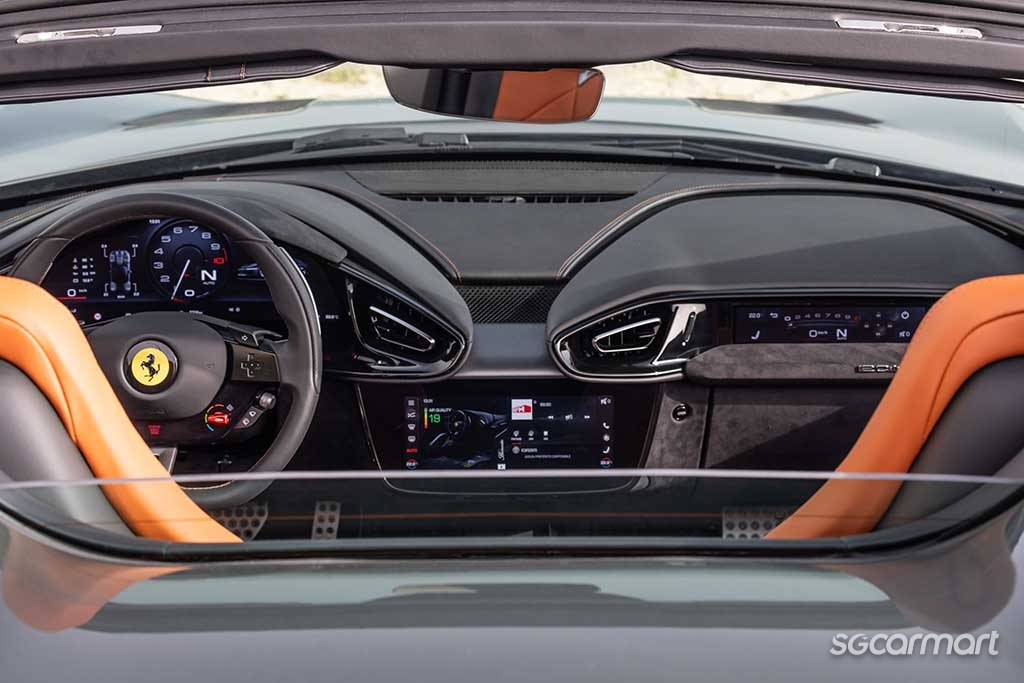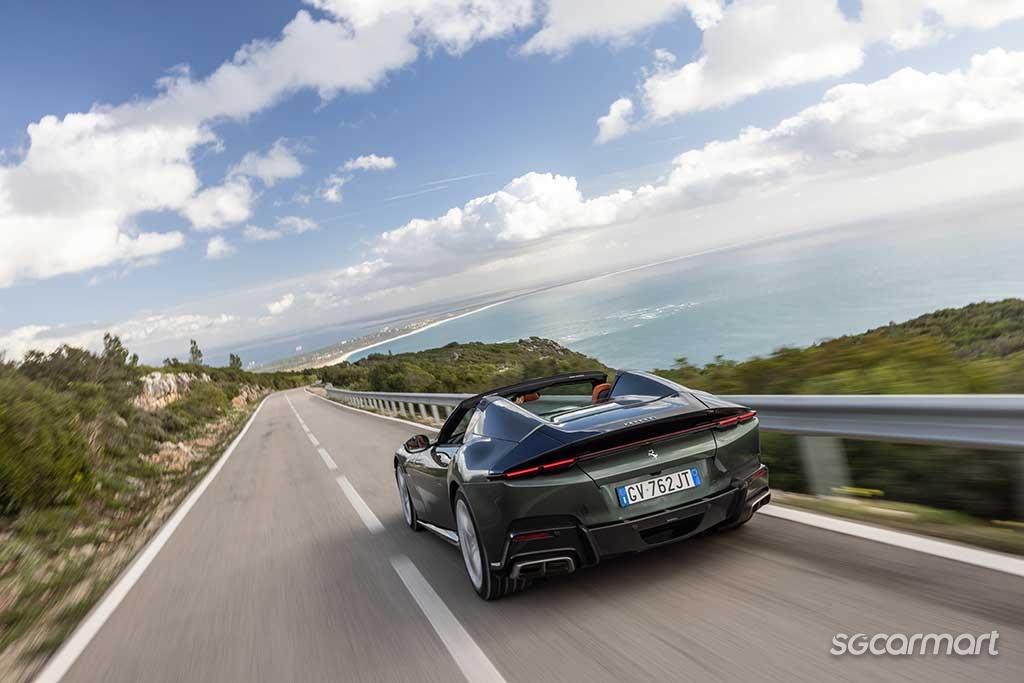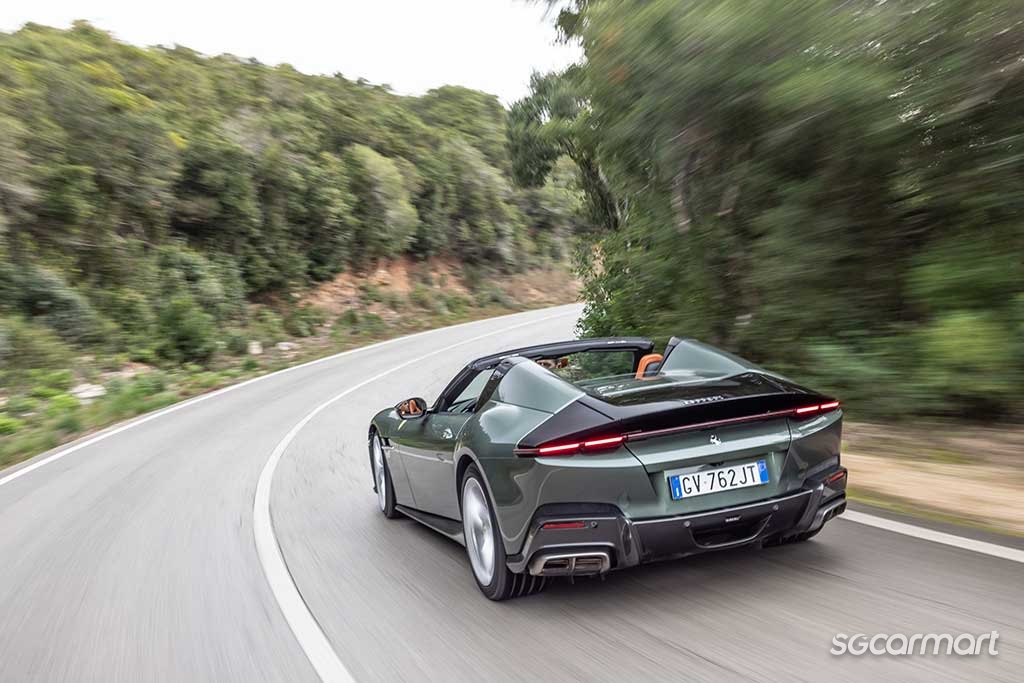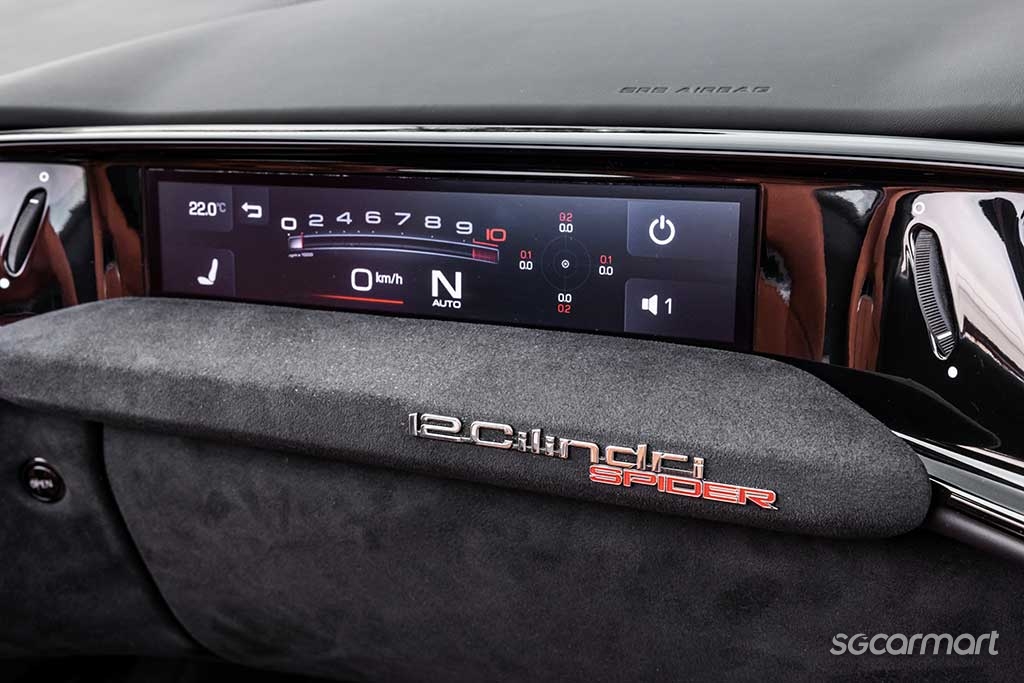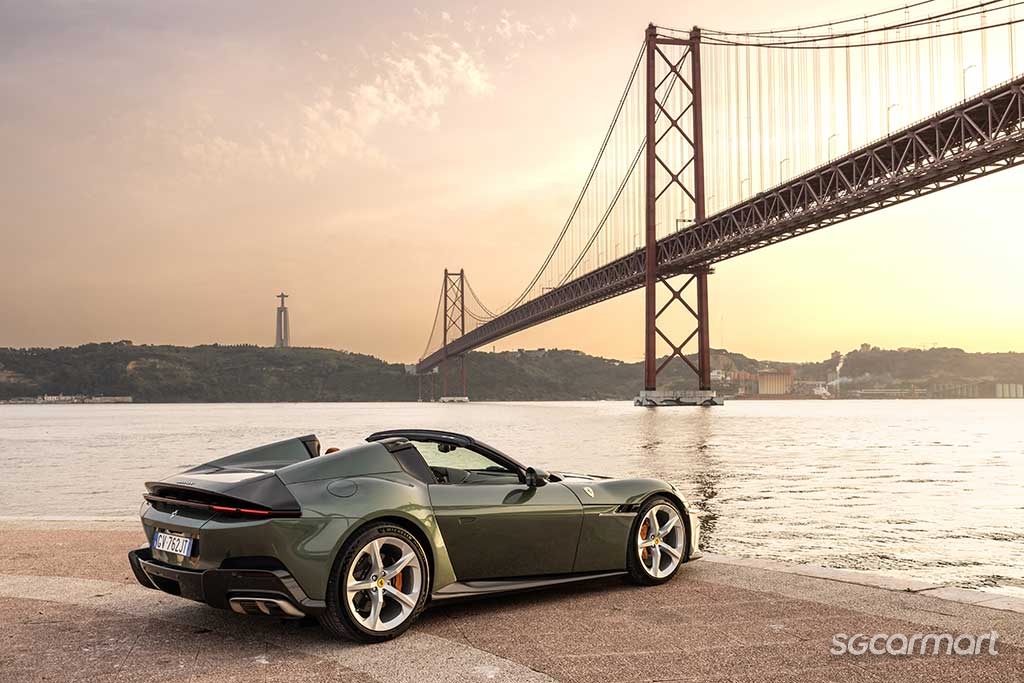Ferrari 12Cilindri Spider First Drive Review
25 Feb 2025|4,984 views
What We Like
Lovely proportions
Head-turning design, especially with roof down
Surprisingly approachable for a powerful rear-wheel drive GT
Predictable, fluid driving character
New tech doesn't meddle with the purity of the driving experience
That unadulterated naturally-aspirated V12!
What We Dislike
V12 bellow feels rather subdued with roof up
Not the most manic Ferrari out there, though we'd also ask: Does it really have to be?
Ferrari's reference to the 12Cilindri Spider as a car "for the few" isn't targeted at its price tag - at least not explicitly - though it's hard to imagine Maranello delivering this statement without a knowing wink. Here in Singapore, it would take more than $2 million to put it on the road.
Instead, however, the firm officially has a different explanation for why it's bestowed the car with such a label: This is a machine made "for the connoisseur, someone with their own unique vision of the perfect Ferrari".
And a unique vision, the 12Cilindri Spider certainly is.
If a driver's palate was geared more towards track-oriented performance in roadgoing form, Ferrari imagines they'd gravitate to the nearly-1,000bhp SF90 Stradale for the main course of hybrid technology and superlative power; for the 296 GTB if they preferred all of that complex yet usable technical wizardry in baby-supercar form. For folks that want something more understated and sensual, but still luxurious and potent, there's the Roma. And even for grown families now, the endlessly debate-spurning Purosangue presents itself with its four doors, four seats, and er, its raised ride height.
Jointly, the 12Cilindri and 12Cilindri Spider occupy a special spot: They're arguably as tradition-steeped as modern Ferraris come.
Traditional two-door grand tourer format aside, the crux here is the 12Cilindri's heart (which is also its name in Italian) and the space carved out for it: A glorious 6.5-litre V12 tucked under an enviably lengthy clamshell, defiantly resisting the assistance of turbos or electric motors. Most of that large, blazing red block is perched just behind the front axle too, contributing to its front-mid-engine layout. And power is sent solely to the rear wheels.
Between the two, the Spider might seem like the harder one to pin down on first glance. After all, purists would vote for a hardtop, which ticks off the right requirements on paper for less weight and more rigidity.
Yet Ferrari is adamant that the Spider is meant to match up in everything GT-esque - the power, the tech, the litheness and agility, and even the comfort - already achieved by the coupe. Testament to this is the claim that both were developed in parallel to each other in pursuit of the same performance philosophy... as well as the fact that they were launched simultaneously. For context (and for those that don't remember), the 812 GTS was unveiled a more leisurely two years after the 812 Superfast broke cover.
When we first set eyes properly on the car right before the drive, there's no doubt that they were designed in parallel. Parked in silence on the brown cobbled-stoned driveway of our hotel in Cascais (just outside central Lisbon), the 12Cilindri Spider is every bit as intriguing to look at as its hard-top twin.
Inspired by the future and the past at once (in particular the 1970s), the idea of visual drama here, when facing the car head on, is more subdued: Cleaner surfaces, and sharper and straighter lines in place of more sculpted curves.
Official materials even go as far as to refer to its design as "disruptive". There are no proper 'eyes' nor 'mouth' in the form of a gaping grille here and thus no conventional 'facial expression' for the Spider. Instead, its bright blade-like daytime-running lights and 365 GTB4-inspired black band lend an air of retrofuturism unlike what we've come to associate with many modern Ferraris.
Expectedly, the rear is where the Spider puts significant distance between itself and its hard-top twin.
The Spider's hard-top roof takes just 14 seconds to retract, and can operate at speeds of up to 45km/h
Making space for the retractable hard-top's tonneau cover has necessitated a drastic reduction in size of the delta wing-shaped rear glass panel. Instead, twin buttresses that serve as the car's roll bar rise out like mountain ridges, then peer over the head rests in the cabin.
Closer inspection reveals a flurry of lines and panels that might raise the eyebrows of those that liked the coupe's gap-less rear (the Spider still gets the twin active aero flaps that rise between 60km/h to 300km/h). Otherwise, the Spider gets the edge in muscularity, thanks to those extra bulges.
Climbing into the car is a pleasant affair, as one is greeted by a space awash in leather, suede and crisp screens. One expects tech and luxury to shake hands firmly in a modern grand tourer, and the cabin fulfils that mission more than confidently. First introduced on the Roma, the dual cockpit design endures as a lovely hallmark now of modern Ferraris too.
The tanned seats are cushy yet supportive, and the hefty steering wheel feels nice in the hands, moulded to perfection for the driver as it sits ahead of those long paddle shifters and the curved digital display. Elsewhere, the thought of using a haptic feedback button for the engine start/stop would not be so alluring - but the mind is quickly conditioned to the anticipation of hearing the V12 rumble to life, and so, even this works here.
In terms of practicality, headroom - unsurprisingly - is no issue when the wind is ruffling your hair, but the Spider is generous in this regard even with the roof up thanks to the dual curvature of the headliner. The extra space occupied by the roof does mean boot space is eaten into as well to land at 200 litres (80 litres less than the coupe), but no one buys a two-door GT for IKEA runs.
The unorthodox majesty of the car and its sheer width (at nearly 2.18 metres!) mean that the first moments spent navigating the sandy coastal roads outside Cascais are marked more by gingerness and restraint. We don't ask how much they cost - but we also don't need to ask, to know that utmost caution should be exercised to ensure the only thing that comes into contact with those new 21-inch rims is air.
It doesn't take long, however, for the 12Cilindri Spider to reveal its first surprise: It's not all that intimidating to drive.
Once the mind has gotten used to the lane widths around Cabo da Roca, some comfort also settles in. Long and wide as that clamshell bonnet may be, placing the Spider on the road is not a Herculean task given the way its front wheel arches rise high enough to mark the corners out.
As a blessing in disguise, perhaps, that helps illuminate the Spider's wide bandwidth, traffic is denser on the first portion of the drive. Rather than the freneticism one might expect from a high-performance rear-wheel drive GT, the experience here at lower speeds is marked by the car's composure and calmness. The steering is accurate but not stone-heavy, and the throttle pedal doesn't threaten to catch you off guard with hyper-sensitivity. Even the brakes feel easy to modulate. Boasting extra rigidity and lightness than the one used on the 812 GTS, Ferrari also states that the Spider's chassis is geared towards comfort. The promise doesn't feel oversold here, ambling through quiet Portuguese towns behind minivans and trucks.
As the traffic clears, however, the 12Cilindri Spider is quick to leap into action.
Though 60kg heavier than its hard-top twin, the immense firepower crackling from Ferrari's latest and most powerful V12 block - capable of the same 819bhp (at 9,250rpm) and 678Nm of torque on the coupe - means that acceleration is almost just as explosive. 0 to 100km/h takes just 2.95 seconds (a mere 0.05-second penalty) in the Spider, and only when powering onwards to 200km/h does the gap between its sprint time and the coupe's widen to 0.3 seconds.
In reality, of course, most of this is scarcely perceptible to the average driver - and certainly not on a countryside drive that doesn't even see the Spider pushed to half its limit. Instead, where it palpably sets the heart racing is with how it steps its drama up in perfect step with a driver's inputs.
Western Portugal's hill passes are sinuous and present frequent changes in elevation, demanding not just agility from a car but also the confidence to shed speed. That the 12Cilindri Spider's wheelbase is shorter than the 812 GTS' already helps the vehicle's sense of tightness, but also part of its playbook now is independent rear-wheel steering. Coupled with the car's scalpel-sharp steering rack, its willingness to shrink and change direction is breathtaking; its added on-paper weight again not really bearing much, well, perceptible weight on its driving character. Meanwhile, the brakes continue to delight with their predictability and linearity.
Also new on the 12Cilindri Spider is an eight-speed dual-clutch transmission that - dependably - is capable of faster shifts. But more exciting arguably is a fresh party trick executed in tandem by Ferrari. Dubbed 'Aspirated Torque Shaping', it sculpts the torque curve in the 3rd and 4th gears (purportedly the "two most important gears for driving on the open road"), teasing the driver with a scarcely-believable sensation of never-ending acceleration right to the point that he or she finally decides to go for the right paddle. The result is glorious.
That the engine finds the redline at 9,500rpm is the cherry on top of the icing. Emissions regulations have it that the current V12, while more powerful, is forced to sing at lower decibels, and while Ferrari states that it's worked hard to pipe the best sounds straight into the cabin, nothing beats having the roof down. Even when the digital display isn't reading out crazy digits (at least not by supercar standards), the bellow of the V12 as its raises both volume and pitch is at once hypnotic and resplendent - although get the Spider up to sufficient speed and one may find it eventually competing with sound of wind buffeting.
Less is more: And truly for the few
The fear is understandably there, but Ferrari's decision to name this current torchbearer for its V12 engine exactly as is shouldn't be misconstrued as a swan song, or a farewell to what has defined the firm for decades.
Rather, it is a love letter to what has served as both Maranello's heart and its soul. The fact that the 12Cilindri exists today without turbocharging or electrical assistance is worth repeating because it is through this resistance that it also effectively vaults into peerless territory. The unadulterated, naturally aspirated V12 may perhaps no longer be the most potent answer to the demand for performance. But it surely is the most thrilling. By losing its top, you expect the Spider to lose a bit of performance too, but if the V12's real prize lies in its smooth drama, then this twin - in the process of bringing you closer to it - is perhaps the one that is peak-magnetic.
What We Like
Lovely proportions
Head-turning design, especially with roof down
Surprisingly approachable for a powerful rear-wheel drive GT
Predictable, fluid driving character
New tech doesn't meddle with the purity of the driving experience
That unadulterated naturally-aspirated V12!
What We Dislike
V12 bellow feels rather subdued with roof up
Not the most manic Ferrari out there, though we'd also ask: Does it really have to be?
Ferrari's reference to the 12Cilindri Spider as a car "for the few" isn't targeted at its price tag - at least not explicitly - though it's hard to imagine Maranello delivering this statement without a knowing wink. Here in Singapore, it would take more than $2 million to put it on the road.
Instead, however, the firm officially has a different explanation for why it's bestowed the car with such a label: This is a machine made "for the connoisseur, someone with their own unique vision of the perfect Ferrari".
And a unique vision, the 12Cilindri Spider certainly is.
If a driver's palate was geared more towards track-oriented performance in roadgoing form, Ferrari imagines they'd gravitate to the nearly-1,000bhp SF90 Stradale for the main course of hybrid technology and superlative power; for the 296 GTB if they preferred all of that complex yet usable technical wizardry in baby-supercar form. For folks that want something more understated and sensual, but still luxurious and potent, there's the Roma. And even for grown families now, the endlessly debate-spurning Purosangue presents itself with its four doors, four seats, and er, its raised ride height.
Jointly, the 12Cilindri and 12Cilindri Spider occupy a special spot: They're arguably as tradition-steeped as modern Ferraris come.
Traditional two-door grand tourer format aside, the crux here is the 12Cilindri's heart (which is also its name in Italian) and the space carved out for it: A glorious 6.5-litre V12 tucked under an enviably lengthy clamshell, defiantly resisting the assistance of turbos or electric motors. Most of that large, blazing red block is perched just behind the front axle too, contributing to its front-mid-engine layout. And power is sent solely to the rear wheels.
Between the two, the Spider might seem like the harder one to pin down on first glance. After all, purists would vote for a hardtop, which ticks off the right requirements on paper for less weight and more rigidity.
Yet Ferrari is adamant that the Spider is meant to match up in everything GT-esque - the power, the tech, the litheness and agility, and even the comfort - already achieved by the coupe. Testament to this is the claim that both were developed in parallel to each other in pursuit of the same performance philosophy... as well as the fact that they were launched simultaneously. For context (and for those that don't remember), the 812 GTS was unveiled a more leisurely two years after the 812 Superfast broke cover.
When we first set eyes properly on the car right before the drive, there's no doubt that they were designed in parallel. Parked in silence on the brown cobbled-stoned driveway of our hotel in Cascais (just outside central Lisbon), the 12Cilindri Spider is every bit as intriguing to look at as its hard-top twin.
Inspired by the future and the past at once (in particular the 1970s), the idea of visual drama here, when facing the car head on, is more subdued: Cleaner surfaces, and sharper and straighter lines in place of more sculpted curves.
Official materials even go as far as to refer to its design as "disruptive". There are no proper 'eyes' nor 'mouth' in the form of a gaping grille here and thus no conventional 'facial expression' for the Spider. Instead, its bright blade-like daytime-running lights and 365 GTB4-inspired black band lend an air of retrofuturism unlike what we've come to associate with many modern Ferraris.
Expectedly, the rear is where the Spider puts significant distance between itself and its hard-top twin.
The Spider's hard-top roof takes just 14 seconds to retract, and can operate at speeds of up to 45km/h
Making space for the retractable hard-top's tonneau cover has necessitated a drastic reduction in size of the delta wing-shaped rear glass panel. Instead, twin buttresses that serve as the car's roll bar rise out like mountain ridges, then peer over the head rests in the cabin.
Closer inspection reveals a flurry of lines and panels that might raise the eyebrows of those that liked the coupe's gap-less rear (the Spider still gets the twin active aero flaps that rise between 60km/h to 300km/h). Otherwise, the Spider gets the edge in muscularity, thanks to those extra bulges.
Climbing into the car is a pleasant affair, as one is greeted by a space awash in leather, suede and crisp screens. One expects tech and luxury to shake hands firmly in a modern grand tourer, and the cabin fulfils that mission more than confidently. First introduced on the Roma, the dual cockpit design endures as a lovely hallmark now of modern Ferraris too.
The tanned seats are cushy yet supportive, and the hefty steering wheel feels nice in the hands, moulded to perfection for the driver as it sits ahead of those long paddle shifters and the curved digital display. Elsewhere, the thought of using a haptic feedback button for the engine start/stop would not be so alluring - but the mind is quickly conditioned to the anticipation of hearing the V12 rumble to life, and so, even this works here.
In terms of practicality, headroom - unsurprisingly - is no issue when the wind is ruffling your hair, but the Spider is generous in this regard even with the roof up thanks to the dual curvature of the headliner. The extra space occupied by the roof does mean boot space is eaten into as well to land at 200 litres (80 litres less than the coupe), but no one buys a two-door GT for IKEA runs.
The unorthodox majesty of the car and its sheer width (at nearly 2.18 metres!) mean that the first moments spent navigating the sandy coastal roads outside Cascais are marked more by gingerness and restraint. We don't ask how much they cost - but we also don't need to ask, to know that utmost caution should be exercised to ensure the only thing that comes into contact with those new 21-inch rims is air.
It doesn't take long, however, for the 12Cilindri Spider to reveal its first surprise: It's not all that intimidating to drive.
Once the mind has gotten used to the lane widths around Cabo da Roca, some comfort also settles in. Long and wide as that clamshell bonnet may be, placing the Spider on the road is not a Herculean task given the way its front wheel arches rise high enough to mark the corners out.
As a blessing in disguise, perhaps, that helps illuminate the Spider's wide bandwidth, traffic is denser on the first portion of the drive. Rather than the freneticism one might expect from a high-performance rear-wheel drive GT, the experience here at lower speeds is marked by the car's composure and calmness. The steering is accurate but not stone-heavy, and the throttle pedal doesn't threaten to catch you off guard with hyper-sensitivity. Even the brakes feel easy to modulate. Boasting extra rigidity and lightness than the one used on the 812 GTS, Ferrari also states that the Spider's chassis is geared towards comfort. The promise doesn't feel oversold here, ambling through quiet Portuguese towns behind minivans and trucks.
As the traffic clears, however, the 12Cilindri Spider is quick to leap into action.
Though 60kg heavier than its hard-top twin, the immense firepower crackling from Ferrari's latest and most powerful V12 block - capable of the same 819bhp (at 9,250rpm) and 678Nm of torque on the coupe - means that acceleration is almost just as explosive. 0 to 100km/h takes just 2.95 seconds (a mere 0.05-second penalty) in the Spider, and only when powering onwards to 200km/h does the gap between its sprint time and the coupe's widen to 0.3 seconds.
In reality, of course, most of this is scarcely perceptible to the average driver - and certainly not on a countryside drive that doesn't even see the Spider pushed to half its limit. Instead, where it palpably sets the heart racing is with how it steps its drama up in perfect step with a driver's inputs.
Western Portugal's hill passes are sinuous and present frequent changes in elevation, demanding not just agility from a car but also the confidence to shed speed. That the 12Cilindri Spider's wheelbase is shorter than the 812 GTS' already helps the vehicle's sense of tightness, but also part of its playbook now is independent rear-wheel steering. Coupled with the car's scalpel-sharp steering rack, its willingness to shrink and change direction is breathtaking; its added on-paper weight again not really bearing much, well, perceptible weight on its driving character. Meanwhile, the brakes continue to delight with their predictability and linearity.
Also new on the 12Cilindri Spider is an eight-speed dual-clutch transmission that - dependably - is capable of faster shifts. But more exciting arguably is a fresh party trick executed in tandem by Ferrari. Dubbed 'Aspirated Torque Shaping', it sculpts the torque curve in the 3rd and 4th gears (purportedly the "two most important gears for driving on the open road"), teasing the driver with a scarcely-believable sensation of never-ending acceleration right to the point that he or she finally decides to go for the right paddle. The result is glorious.
That the engine finds the redline at 9,500rpm is the cherry on top of the icing. Emissions regulations have it that the current V12, while more powerful, is forced to sing at lower decibels, and while Ferrari states that it's worked hard to pipe the best sounds straight into the cabin, nothing beats having the roof down. Even when the digital display isn't reading out crazy digits (at least not by supercar standards), the bellow of the V12 as its raises both volume and pitch is at once hypnotic and resplendent - although get the Spider up to sufficient speed and one may find it eventually competing with sound of wind buffeting.
Less is more: And truly for the few
The fear is understandably there, but Ferrari's decision to name this current torchbearer for its V12 engine exactly as is shouldn't be misconstrued as a swan song, or a farewell to what has defined the firm for decades.
Rather, it is a love letter to what has served as both Maranello's heart and its soul. The fact that the 12Cilindri exists today without turbocharging or electrical assistance is worth repeating because it is through this resistance that it also effectively vaults into peerless territory. The unadulterated, naturally aspirated V12 may perhaps no longer be the most potent answer to the demand for performance. But it surely is the most thrilling. By losing its top, you expect the Spider to lose a bit of performance too, but if the V12's real prize lies in its smooth drama, then this twin - in the process of bringing you closer to it - is perhaps the one that is peak-magnetic.
Car Information
Ferrari 12Cilindri Spider 6.5 V12 (A)
$2,071,475 (w/o COE)
CAT B|Petrol|n/a
Horsepower
619kW (830 bhp)
Torque
678 Nm
Acceleration
2.95sec (0-100km /hr)
Thank You For Your Subscription.
- The Original Ferrari
- Disruptive Design
- Grand Tourer For The New Age
- Breathtakingly Versatile
- For The Few




































